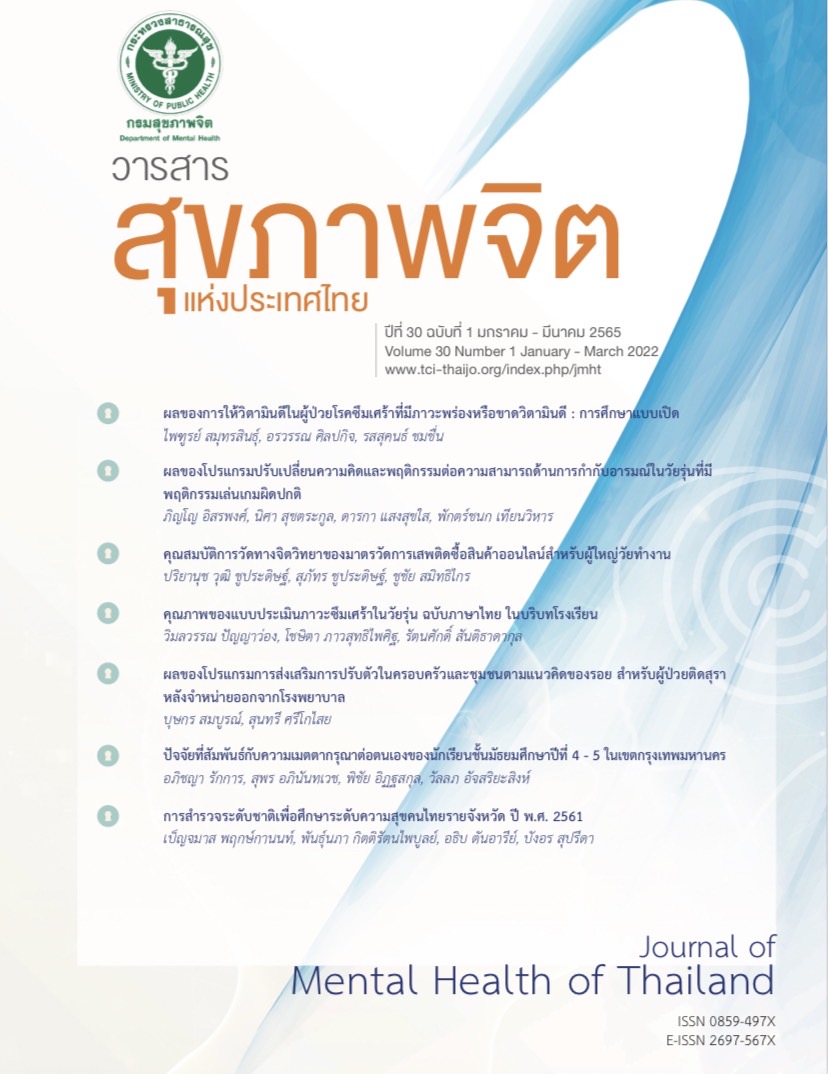คุณภาพของแบบประเมินภาวะซึมเศร้าในวัยรุ่น ฉบับภาษาไทย ในบริบทโรงเรียน
คำสำคัญ:
ซึมเศร้า, แบบประเมินภาวะซึมเศร้าในวัยรุ่น, โรงเรียน, วัยรุ่นบทคัดย่อ
วัตถุประสงค์ : เพื่อทดสอบคุณภาพของแบบประเมินภาวะซึมเศร้าในวัยรุ่น (patient health questionnaire for adolescents; PHQ-A) ในบริบทโรงเรียน
วิธีการ : เป็นการศึกษาต่อเนื่องจากโครงการวิจัยสำรวจความชุกภาวะซึมเศร้าในวัยรุ่นอายุ 11 - 19 ปี จำนวน 5,345 คน โดยระยะนี้ศึกษาเฉพาะเขตสุขภาพภาคกลาง กลุ่มตัวอย่าง ได้แก่ กลุ่มเสี่ยงต่อภาวะซึมเศร้า (PHQ-A ตั้งแต่ 10 คะแนนขึ้นไป) จำนวน 292 คน และกลุ่มที่มีผลการคัดกรองเป็นลบที่ได้รับการเลือกโดยการสุ่มจำนวน 130 คน (ร้อยละ 10 ของทั้งหมด) กลุ่มตัวอย่างได้รับการประเมิน PHQ-A อีกครั้งและรับการสัมภาษณ์เพื่อวินิจฉัยโดยจิตแพทย์เด็กและวัยรุ่น วิเคราะห์ความเที่ยงและความตรงของเครื่องมือโดยตัดกลุ่มที่ถูกวินิจฉัยโรควิตกกังวลและกลุ่มโรคปัญหาการปรับตัวออก เหลือกลุ่มตัวอย่าง 389 คน (กลุ่มซึมเศร้า 69 คน และกลุ่มไม่ซึมเศร้า 320 คน)
ผล : แบบประเมิน PHQ-A มีความเที่ยงแบบความสอดคล้องภายในอยู่ในระดับดี (Cronbach’s alpha coefficient = 0.88) การวิเคราะห์ ROC เทียบกับผลการวินิจฉัยของจิตแพทย์ มีพื้นที่ใต้โค้ง (AUC) เท่ากับ 0.91 (SD = 0.02, 95% CI 0.88 - 0.94) จุดตัดที่มีความตรงตามเกณฑ์ที่น่าพอใจที่สุดคือ 10 คะแนน (ความไวร้อยละ 93 และความจำเพาะร้อยละ 77) กลุ่มที่ได้รับการวินิจฉัยภาวะซึมเศร้าร้อยละ 86 มีคะแนน PHQ-A ในช่วงซึมเศร้าปานกลางถึงมาก (10 - 19 คะแนน) ส่วนกลุ่มไม่ซึมเศร้าร้อยละ 77.5 มีคะแนน PHQ-A ต่ำกว่า 10 คะแนน
สรุป : แบบประเมิน PHQ-A ฉบับภาษาไทย สามารถใช้คัดกรองและติดตามภาวะซึมเศร้าในวัยรุ่นในบริบทโรงเรียน โดยแนะนำให้ใช้จุดตัดคะแนนที่ 10 คะแนนขึ้นไป แต่อาจปรับการใช้และจุดตัดได้ตามวัตถุประสงค์ของการใช้แบบประเมิน
Downloads
เอกสารอ้างอิง
American Psychological Association. Clinical practice guideline for the treatment of depression across three age cohorts [Internet]. Washington, DC: American Psychological Association; 2019 [cited 2021 Nov 25]. Available from https://www.apa.org/depression-guideline.
Guidelines on mental health promotive and preventive interventions for adolescents: helping adolescents thrive. Executive summary. Geneva: World Health Organization; 2021.
World Health Organization (WHO). Mental health status of adolescents in south-east Asia: evidence for action [Internet]. New Delhi: World Health Organization, Regional Office for South-East Asia; 2017 [cited 2018 Nov 16]. Available from: http://apps.who.int/iris/handle/10665/254982
GBD 2015 Disease and Injury Incidence and Prevalence Collaborators. Global, regional, and national incidence, prevalence, and years lived with disability for 310 diseases and injuries, 1990–2015: a systematic analysis for the global burden of disease study 2015. Lancet. 2016;388(10053):1545-602. doi:10.1016/S0140-6736(16)31678-6.
Jones PB. Adult mental health disorders and their age at onset. Br J Psychiatry Suppl. 2013;54:s5-10. doi:10.1192/bjp.bp.112.119164.
Nelson J, Klumparendt A, Doebler P, Ehring T. Childhood maltreatment and characteristics of adult depression: meta-analysis. Br J Psychiatry. 2017;210(2):96-104. doi:10.1192/bjp.bp.115.180752.
World Health Organization. Health for the world’s adolescents: a second chance in the second decade. Geneva: World Health Organization; 2014.
World Health Organization. Depression and other common mental disorders: global health estimates. Geneva: World Health Organization; 2017.
ราชวิทยาลัยกุมารแพทย์แห่งประเทศไทย, ชมรมจิตแพทย์เด็กและวัยรุ่นแห่งประเทศไทย และสถาบันสุขภาพจิตเด็กและวัยรุ่นราชนครินทร์. คู่มือปฏิบัติการดูแลวัยรุ่นที่มีภาวะซึมเศร้า สำหรับบุคลากรสาธารณสุขและบุคลากรทางการศึกษา ตามแนวทางการดูแลวัยรุ่นที่มีภาวะซึมเศร้า [A practical guide to caring for adolescents with depression]. กรุงเทพฯ: บียอนด์ พับลิชชิ่ง; 2561.
Siu AL, US Preventive Services Task Force. Screening for depression in children and adolescents: US preventive services task force recommendation statement. Pediatrics. 2016;137(3):e20154467. doi:10.1542/peds.2015-4467.
Zuckerbrot RA, Cheung A, Jensen PS, Stein REK, Laraque D, GLAD-PC steering group. Guidelines for adolescent depression in primary care (GLAD-PC): Part I. Practice preparation, identification, assessment, and initial management. Pediatrics. 2018;141(3);e20174081. doi:10.1542/peds.2017-4081.
National Institute for Health and Care Excellence (NICE). Depression in children and young people: identification and management [NICE guideline no. 134]. National Institute for Health and Care Excellence; 2019 [cited 2021 Nov 25]. Available from: www.nice.org.uk/guidance/ng134
Panyawong W, Pavasuthipaisit C, Santitadakul R. Validation of the Thai version of the patient health questionnaire for adolescents (PHQ-A) in adolescent psychiatric patients. Int J Child Dev Ment Health. 2020;8(1);30-40.
Kronke K, Spitzer RL, Williams JB. The PHQ-9: validity of a brief depression severity measure. J Gen Intern Med. 2001;16(9):606-13. doi:10.1046/j.1525-1497.2001.016009606.x.
Johnson JG, Harris ES, Spitzer RL, Williams JBW. The patient health questionnaire for adolescents: validation of an instrument for the assessment of mental disorders among adolescent primary care patients. J Adolesc Health. 2002;30(3):196-204. doi:10.1016/s1054-139x(01)00333-0.
Beirão D, Monte H, Amaral M, Longras A, Matos C, Villas-Boas F. Depression in adolescence: a review. Middle East Curr Psychiatry. 2020;27(50). doi:10.1186/s43045-020-00050-z.
วิมลวรรณ ปัญญาว่อง, รัตนศักดิ์ สันติธาดากุล, โชษิตา ภาวสุทธิไพศิฐ. ความชุกของภาวะซึมเศร้าและความเสี่ยงฆ่าตัวตายในวัยรุ่นไทย: การสำรวจโรงเรียนใน 13 เขตสุขภาพ [Prevalence of depression and suicidal risks in Thai adolescents: a survey in schools from 13 health areas]. วารสารสุขภาพจิตแห่งประเทศไทย. 2563;28(2):136-49.
สำนักนโยบายและยุทธศาสตร์ กระทรวงสาธารณสุข. ประชากรกลางปี 59 [Mid population 2559] [อินเทอร์เน็ต]. นนทบุรี: กระทรวงสาธารณสุข; 2560 [สืบค้นเมื่อวันที่ 15 ม.ค. 2561]. จาก: http://bps.moph.go.th/new_bps/sites/default/files/Mid%20Population%202559.pdf
Krejcie RV, Morgan DW. Determining sample size for research activities. Educ Psychol Meas. 1970;30(3):607-10.
Thapar A, Collishaw S, Pine DS, Thapar AK. Depression in adolescence. Lancet. 2012;379(9820):1056-67. doi:10.1016/S0140-6736(11)60871-4.
Manea L, Gilbody S, McMillan D. Optimal cut-off score for diagnosing depression with the patient health questionnaire (PHQ-9): a meta-analysis. CMAJ. 2012;184(3):e191-6. doi:10.1503/cmaj.110829.
American Psychiatric Association. Diagnostic and statistical manual of mental disorder. 5th ed. Arlington VA: American Psychiatric Association; 2013. p. 155-88.
Busner J, Targum SD. The clinical global impressions scale: applying a research tool in clinical practice. Psychiatry (Edgmont). 2007;4(7):29-37.
Kroenke K, Spitzer RL, Williams JBW, Löwe B. The patient health questionnaire somatic, anxiety, and depressive symptom scales: a systematic review. Gen Hosp Psychiatry. 2010;32:345-59. doi:10.1016/j.genhosppsych.2010.03.006
Richardson LP, McCauley E, Grossman DC, McCarty CA, Richards J, Russo JE, et al. Evaluation of the patient health questionnaire-9 item for detecting major depression among adolescents. Pediatrics. 2010;126(6):1117-23. doi:10.1542/peds.2010-0852.
Tsai FJ, Huang YH, Liu HC, Huang KY, Huang YH, Liu SI. Patient health questionnaire for school-based depression screening among Chinese adolescents. Pediatrics. 2014;133(2):e402e9. doi:10.1542/peds.2013-0204.
Du N, Yu K, Ye Y, Chen. Validity study of patient health questionnaire‐9 items for internet screening in depression among Chinese university students. Asia Pac Psychiatry. 2017;9:e12266. doi:10.1111/appy.12266.
Ganguly S, Samanta M, Roy P, Chatterjee S, Kaplan DW, Basu B. Patient health questionnaire-9 as an effective tool for screening of depression among Indian adolescents. J Adolesc Health. 2013;52:546-51. doi:10.1016/j.jadohealth.2012.09.012.
Naveed S, Waqas A, Memon AR, Jabeen M, Sheikh MH. Cross-cultural validation of the Urdu translation of the patient health questionnaire for adolescents among children and adolescents at a Pakistani school. Public Health. 2019;168:59-66. doi:10.1016/j.puhe.2018.11.022.
Law WC, McClanahan R, Weismuller PC. Depression screening in the school setting identification of the depressed adolescent. NASN Sch Nurse. 2017;32(6):364-70. doi:10.1177/1942602X17726095.
ดาวน์โหลด
เผยแพร่แล้ว
รูปแบบการอ้างอิง
ฉบับ
ประเภทบทความ
สัญญาอนุญาต
ลิขสิทธิ์ (c) 2022 วารสารสุขภาพจิตแห่งประเทศไทย

อนุญาตภายใต้เงื่อนไข Creative Commons Attribution-NonCommercial-NoDerivatives 4.0 International License.
- ผู้อ่านสามารถนำข้อความ ข้อมูล จากวารสารไปใช้ไปใช้ประโยชน์ทางวิชาการได้ เช่น เพื่อการสอน เพื่อการอ้างอิง แต่การนำไปใช้เพื่อวัตถุประสงค์อื่น เช่น เพื่อการค้า จะต้องได้รับอนุญาตเป็นลายลักษณ์อักษรจากกรมสุขภาพจิตก่อน
- ความคิดเห็น ข้อมูล และบทสรุปต่าง ๆ ที่ลงตีพิมพ์ในวารสารสุขภาพจิตแห่งประเทศไทยเป็นของผู้เขียนบทความและมิได้แสดงว่ากองบรรณาธิการหรือกรมสุขภาพจิตเห็นพ้องด้วย




